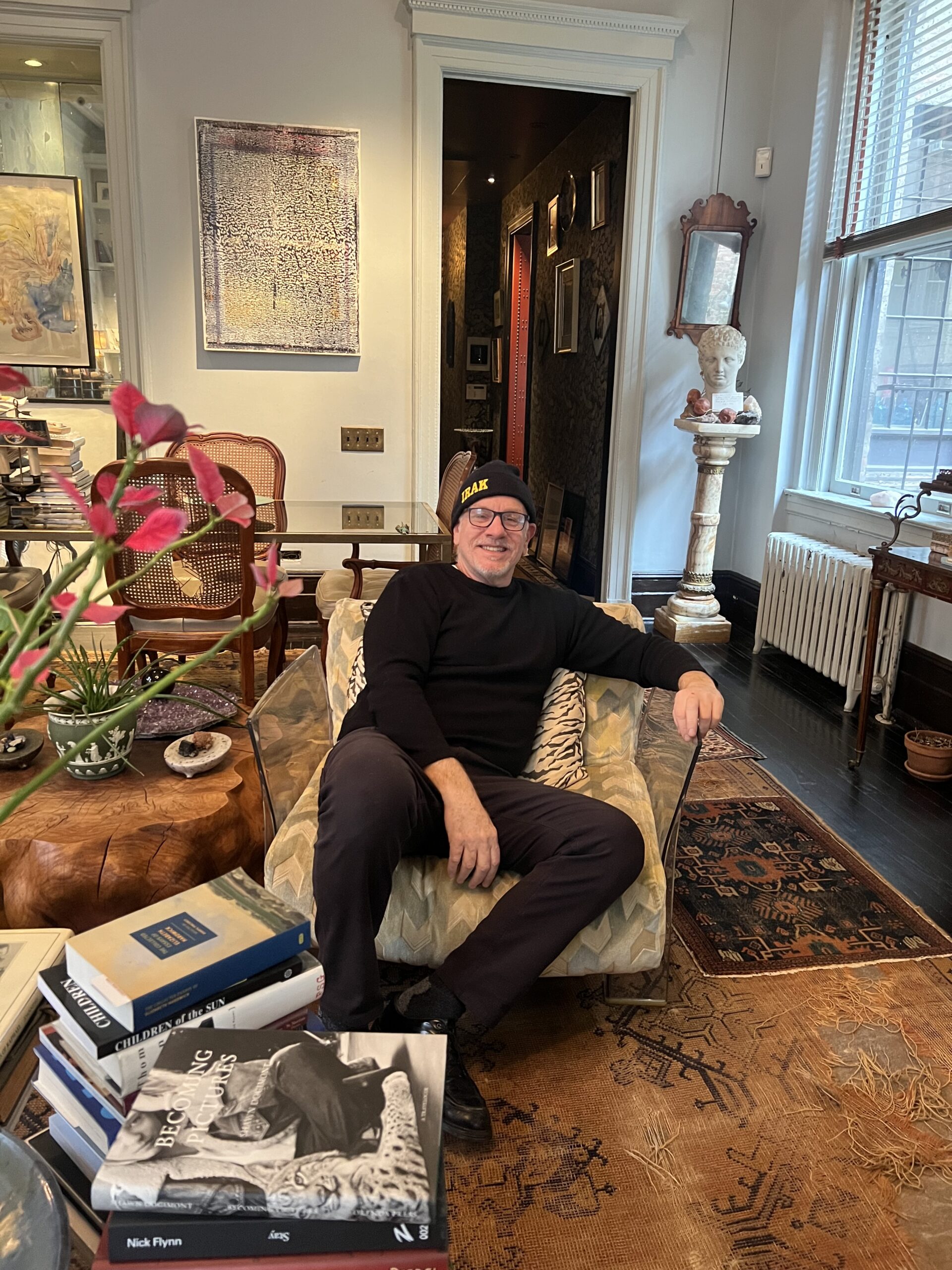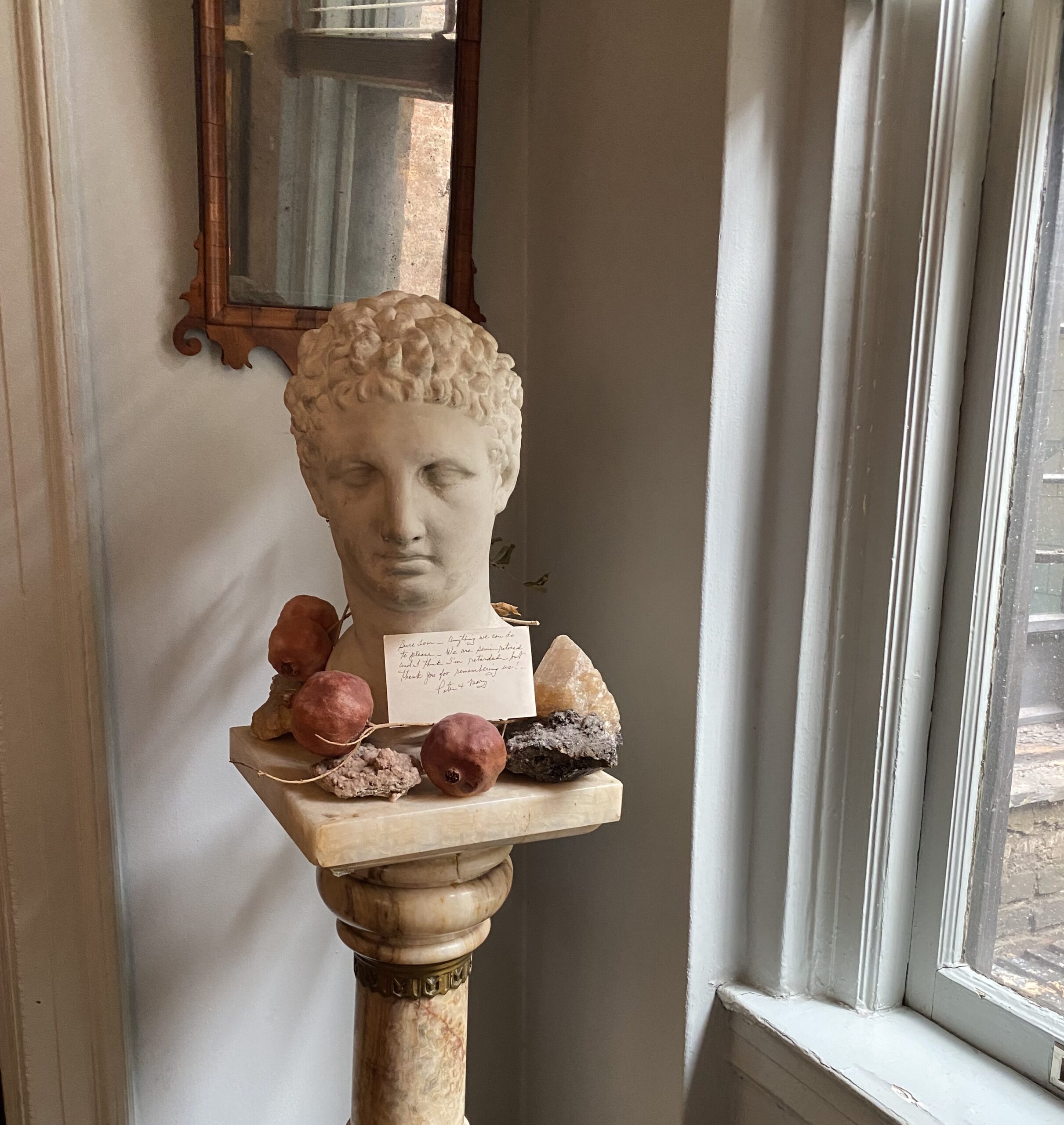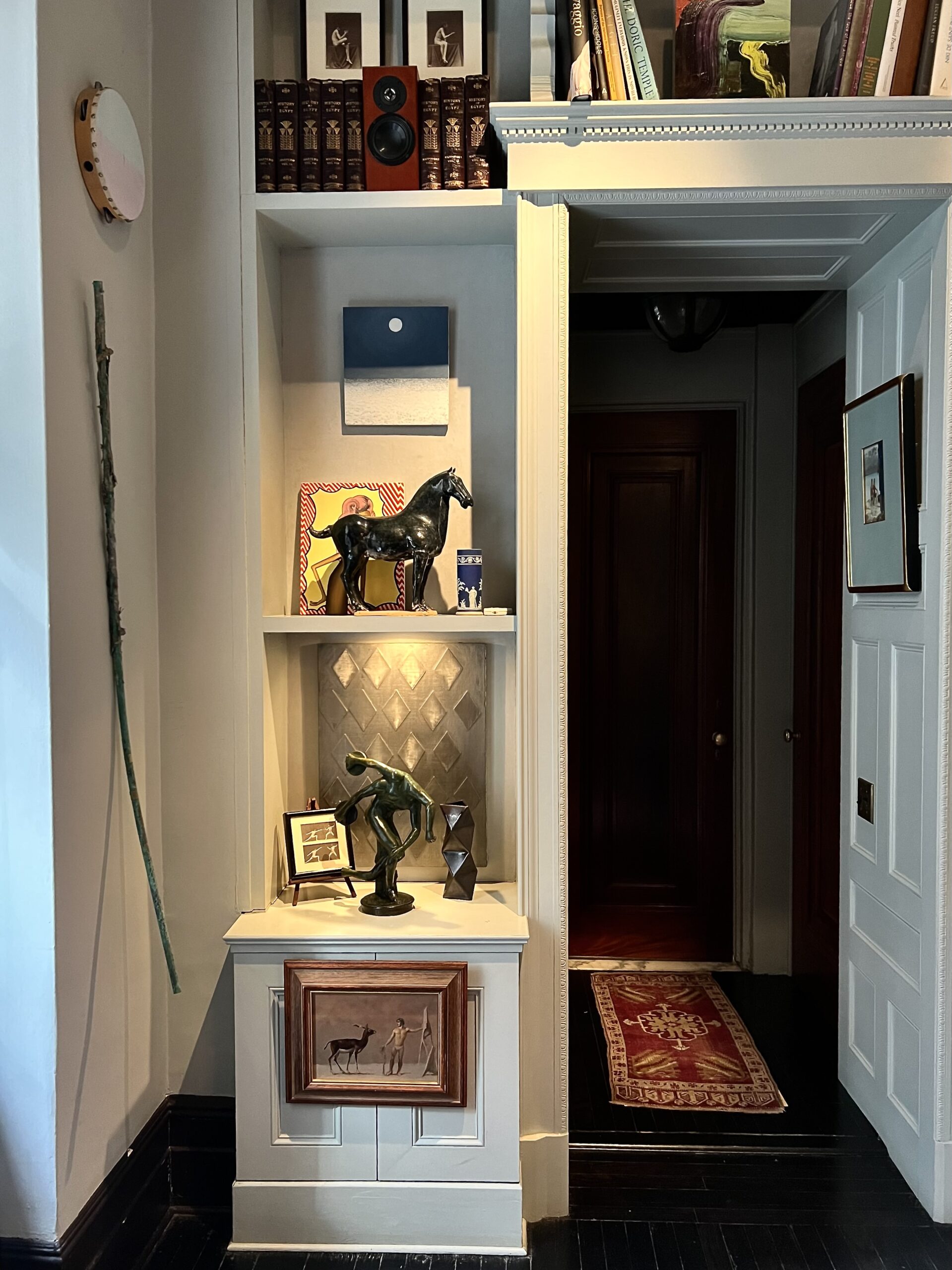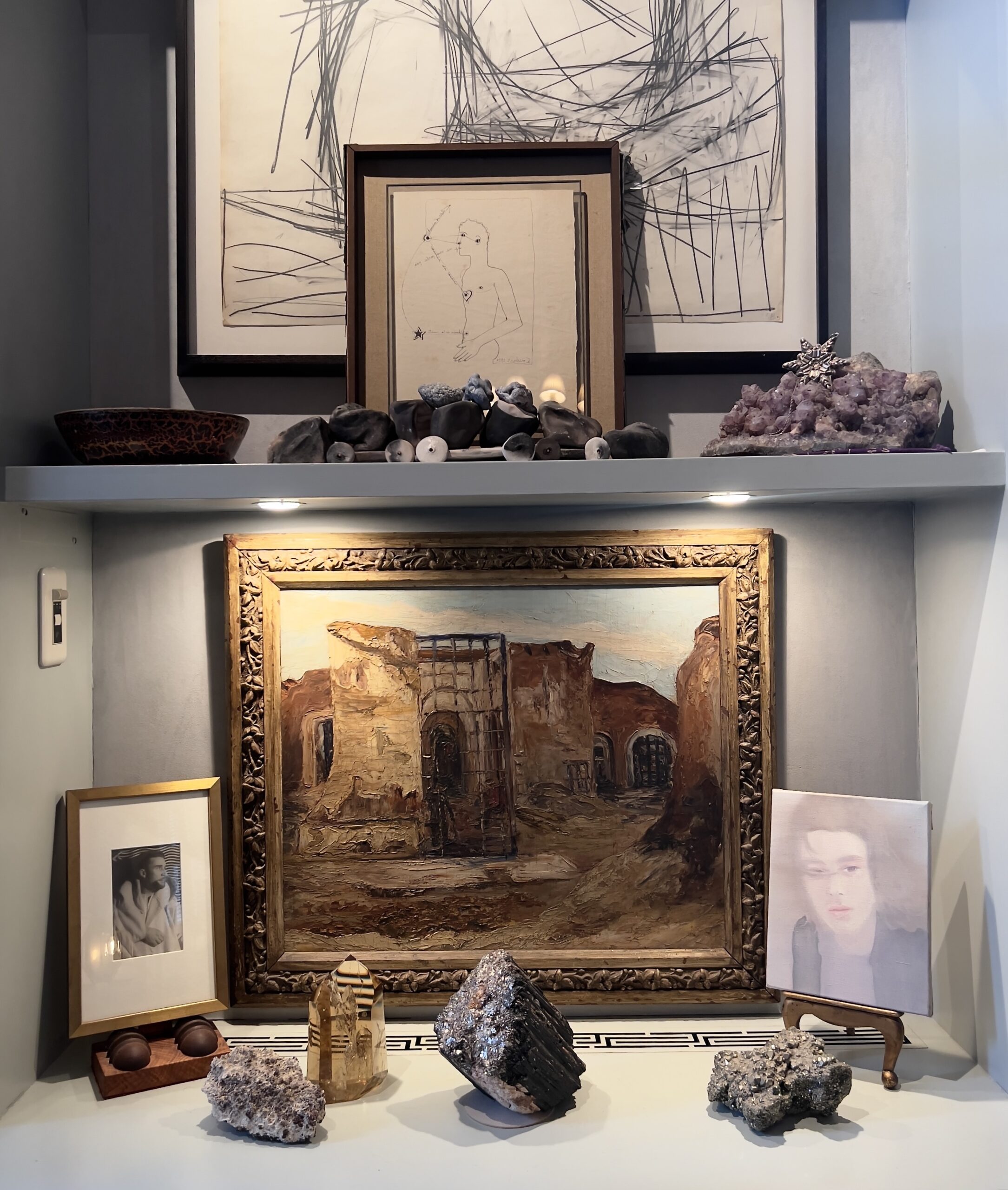
Jack Pierson, photographed by Emily Sandstrom.
Artist and photographer Jack Pierson opened Elliott Templeton Fine Arts in Chinatown last fall, joining the cluster of existing galleries on an otherwise residential and unassuming block. Named after the lavish and aristocratic character in William Somerset Maugham’s novel The Razor’s Edge, Elliott Templeton has a uniquely romantic atmosphere. Designed by interiors wizard Fernando Santangelo, who’s also responsible for the heavenly Nine Orchard hotel and the semi-recent redesign of the Chateau Marmont, the gallery is embellished with a chaise lounge and antique bronzed light fixtures which decorate its champagne walls.
The gallery’s inaugural show was made up of pieces from Pierson’s own collection, sourced and inspired largely by his visits to antique stores across the country that house the collections of predominantly gay artists. On a grey and cloudy morning last week, Pierson (who shot our most recent Bad Bunny cover) took me inside his charming Greenwich Village home to get a closer look at his personal collection. The photographer, who’s own works will be shown at Lisson Gallery in May, seemed to be just as enamored by treasures gifted from beatnik artists he’s met over his storied career as he is the blue-chip masterpieces that hang alongside them.
———

PHONE TABLE
“Working with Fernando, part of our inspiration was this dilapidated grand hotel in Istanbul that we both like called Pera Palace. Many people know it, it’s probably in a lot of novels from that time. This little table used to be where you put the phone. A tall phone, the kind that you grab. Then there is some amber and this piece of lapis lazuli I got in São Paulo. This necklace was made by a guy in Goa that strung beads on the beach. I fell in love with him for an afternoon. Not him so much, but the whole idea of stringing beads on the beach for your life.”
MAPPLETHORPE
“This is one of the first things I ever bought at auction. It’s a Robert Mapplethorpe polaroid of Patti Smith. It happens to be the cover of one of her books of poetry that I got when I was 16 years old, visiting Gotham Book Mart in New York when I lived in Massachusetts.”
CITRINE CRYSTAL
“Well… I went through a crystal moment.”
———

COCKTAIL TABLE
“John Derian gave me this little cocktail table. This tray lifts off and you can serve with it.”
PICASSO
“This Picasso etching I got in Paris, after a show I had there. I decided I had to have Picasso’s autograph, and I love it. It is signed Bon À Tirer (B.A.T), which is like a gift of the artist. It means ‘good to pull.’ The fact that he wrote that as opposed to just the name made me feel like I was getting a bargain.”
———

“This is just a cheap bust of Hermes that I found. The pedestal is Fernando channeling Pera Palace. The card is an autograph from Peter and Mary, from Peter, Paul and Mary, who were folk singers in Greenwich Village. Somebody gave it to me, because in my childhood, they were like Gods. They had a song called ‘Puff the Magic Dragon,’ which you learned when you got into your teenage years was really about marijuana. Mary Travers was one of the most beautiful women who ever lived. So ungodly beautiful. They were my first beckoning to beatnik living and Greenwich Village. The dried pomegranates were grown at my house in California.”
———


PAT DE GROOT
“I don’t know what the fuck to tell you about that. It’s a Pat de Groot painting. She was a landlady of mine in Provincetown for many years. She was the ultimate beatnik and bohemian, but came from Park Avenue society. Supposedly her mother was the production designer of the Black and White Ball. Pat couldn’t have been further from that. She ran to Provincetown and made these gorgeous paintings because she lived in a huge house by the sea. She would rent rooms very illegally for the summer. For many years, John Waters was on the top floor, I was on the second floor and she was on the ground floor. There was only an outdoor shower. Like, you had to go downstairs and outside to take a shower.”
HORSE SCULPTURE
“The horses are a joke about bourgeois decorating.”
———

“The gorgeous background is a Ross Bleckner painting he gave me when I moved in here.”
RIGHT SCULPTURE
“The bronze sculpture is a Mark Flood, which we just showed a version of at Elliott Templeton Fine Arts.”
LEFT SCULPTURE
“The little photograph on the easel is an [Eadweard] Muybridge. If it’s a page from a book, I paid way too much. I got it on a road trip six or seven years ago. We pulled over in a town in Northern California that had this big double story house on an old Western main street, with a balcony over the street. It was an antique store, twice the size of this room, chock-a-block full of great stuff. I walked in and the soundtrack to Hair was playing and no one was in there. Finally, a voice piped up and it was the owner who was really cranky. I wound up chatting with him for like two hours. He showed me upstairs where he lived with his lover for many years and all the things they collected. He said, ‘Well, the whole thing’s for sale. I’ll sell it to you and move to Palm Springs in two seconds.’ I wish I had gotten his number.”
———

” This is by John B. Lear. I found this in an antique store in Palm Springs. Another one of these stores where a gay guy sits and decorates to his taste. And if he sells it, all the better. As far as I’m concerned, he discovered this guy. The prices on his work seem to have jumped all of a sudden. This gay art used to be like, beyond the pale and nobody wanted it. Now, all of a sudden people are into it. I don’t know whether it’s the archival movement that’s going on for like lost gay history or whether it’s just all gay guys that can afford what they want and they don’t give a shit anymore.”
———

TOP CENTER
“That is a Jean Cocteau drawing I got at an auction in Paris. I always dreamed of having a Cocteau. This is a pretty good one from 19… What does it say? It’s backwards. Twenty four! Can that be true? If it is, then it’s a damn good one.”
“This little thing is blue coral, which I stole from the Philippines. You’re not supposed to harvest it but I couldn’t resist.”
“This train was made by Phyllis Goldberg who lived in my building when I lived at 10 Downing Street, across from Bar Pitti. She was this little old lady with thick glasses. One day she stopped me in the elevator and said, ‘Are you the Jack Pierson that was in The New York Times this weekend?’ She was an artist too. We became friends and she took a ceramic workshop and made these little trains, which were based on the trains taking people to concentration camps. They’re like burnt bones. It’s much, much sadder than it looks, because it’s sort of whimsical and charming.”
BOTTOM CENTER
“When I’ve talked about Elliot Templeton before, I’ve talked about gay antique stores that used to exist in New York. The owners would open when they wanted to, close when they wanted to, and would pass the time of day with you and have interesting stories. One of the most famous owners who was around the longest was this guy named Joel, who was on Father Demo Square on 6th Avenue. I would religiously walk by when my studio was on Canal Street. Sometimes he’d be there at 10 o’clock at night because he had nothing better to do. It was like his living room. I got that painting from him. I don’t think it has a name attached to it. He didn’t know much about it except that it looked great.”
———
“This is a photograph by my friend Rocky Schenck. There’s a black and white photograph under there, it’s embellished by photo toner, which is an old process that’s very labor intensive. It’s like a grease that’s put on and then brushed away. He lives in Hollywood. The first time I ever went to L.A. I wanted to stay longer, but I didn’t have any money. I met Rocky, and he was like, ‘You can stay at my house and work for me for a couple of weeks.’ So he taught me how to do this. Those two weeks in L.A. were life changing to me. Being broke, having time to look at things. Later when I could, I bought a work from one of his shows.”
———

“I’m very proud of this complete set of books, the works of Barbara Pym, who’s one of my favorite writers. Her subject matter is the English spinster, of which she was one. She draws a comparison between spinsters and artists because they have this endless amount of time to observe and pass judgment. They’re incredibly funny.”
———

“The red one and the blue ones are Richard Tinkler. The picture on the left is my father, and the picture on the right is a Hugo Guinness, who we’ll eventually do a show with.”
———

“This is one of my favorite things. It’s an Italian movie poster of Roman Spring of Mrs. Stone, which is a Tennessee Williams screenplay that starred Warren Beatty and Vivien Leigh. He’s so handsome, she’s so pretty. What more could you want? A lot of people would say, ‘It’s just a poster,’ but to me, it’s as good as this Brice Marden…”


